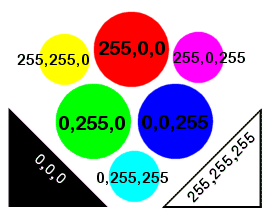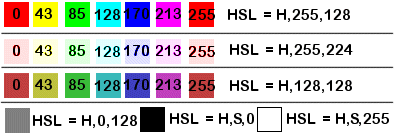RGB (RED/GREEN/BLUE) is an additive color method. It is the method used in monitors. Monitors emit light to produce color. The three primary colors are measured on a scale of 0-255. The primary colors are mixed to create the secondary colors.
Pure Red = 255 RED, 0 Green, 0 Blue.
YELLOW = 255 RED, 255 GREEN, 0 BLUE.
The absence of all primary colors (0,0,0) creates black, and 100% of all primary colors (255,255,255) creates white.

HSL (HUE/SATURATION/LIGHT) is how our eyes perceive color. Each fraction is also measured on a scale of 0-255.
HUE is the color fraction (256 colors, 255 and the 0). You can think of it as a circle beginning at 0 = red and ending at 255= red. Directly opposite red is cyan at 128.
SATURATION is the strength of the color, or the amount of gray tones. At 255 there is a small amount of gray and the color is very vivid. At 0 there is a desaturation of color and a large amount of gray tones. Grayscale is the total desaturation of color to the point that there are 256 shades of gray.
LIGHT intensity is measured as 0 = total darkness (black) and 255 = total lightness (white). At 128, or 50% light, the hue is considered to be pure.

CMYK (CYAN/MAGENTA/YELLOW/BLACK) is the method used in printers. It is based on color being absorbed and then reflected by the ink. This is a subtractive color method. The secondary colors Cyan, Magenta, and Yellow are each combined to make the primary colors. If all three are combined they create black, but since the mixtures of ink vary between manufacturers, they have added Black ink.
Images are divided into layers of color or channels. RGB and HSL would have three colors and CMYK would have four. PSP adds the Alpha channel which stores the lightness values (like in masks). With PSP you can split an image into its respective channels and PSP will create grayscale images of each channel that you can edit (then recombine), without effecting the origianl. See the table below of an image split into its RGB, HSL, and CMYK channels (notice they are grayscaled).










